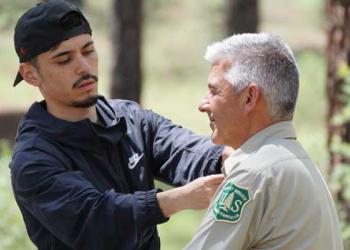Wilderness
The Gila National Forest boasts three designated wilderness areas, the Aldo Leopold Wilderness, Blue Range Wilderness, and Gila Wilderness. The three wilderness areas together total 792,584 acres, or approximately 24% of the Gila National Forest. The Gila Wilderness, at 559,688 acres, is New Mexico's largest wilderness with an extensive trail system providing access. The Gila Wilderness is also the world's first designated wilderness, created on June 3, 1924 at the urging of the great conservation pioneer Aldo Leopold. The Aldo Leopold Wilderness lies to the east, while towards the west, the smaller Blue Range Wilderness adjoins Arizona's rugged Blue Range Primitive Area.
In addition to designated wilderness areas, the Gila has two Wilderness Study Areas, Hell Hole WSA and Lower San Francisco WSA, which are managed to retain their wilderness character until Congress acts to either designate as wilderness or release from wilderness study.
Wilderness Ethics
In wilderness there are no roads; the only travel permitted is by foot or horseback. You will find no logging, resorts nor commercial uses of any kind except grazing. Hunting and fishing, however, are open to all citizens under New Mexico game laws.
Please follow these simple points to maintain our wilderness:
- Motorized vehicles are not permitted in the wilderness.
- Mechanized equipment (including mountain bikes) may not be used in the wilderness.
- Leave no trace of your visit.
- Check with the local land management agency for trail information and other considerations.
Wilderness Areas
The United States Congress designated the Aldo Leopold Wilderness in 1980 and it has a total of 202,016 acres. All of the wilderness is in New Mexico and is managed by the Gila National Forest. The wilderness area lies along the cest of the Black Range.
The area with the Aldo Leopold Wilderness was formerly part of the Gila Wilderness. The Aldo Leopold Wilderness was named for one of history's most influential conservationists, and protects the roughest, wildest portions of one of New Mexico's wildest corners -- the Black Range. The elevations in the Aldo Leopold Wilderness range from 6,000 feet to 10,165 feet. The Aldo Leopold is rugged and remote and is often considered New Mexico's "wildest wilderness."
The 29,304 acre Blue Range Wilderness was designated in 1980 and is located on the western border of New Mexico and is managed by the Gila National Forest. It adjoins the Blue Range Primitive Area, which is managed by the Apache-Sitgreaves National Forests in Arizona.
The 559,688-acre Gila Wilderness, created in June 1924 at the urging of the great conservation pioneer Aldo Leopold, was the world's first designated wilderness and also New Mexico's largest wilderness.
Gila Wilderness Centennial
In 2024, the Gila National Forest, its partners, and communities celebrated the 100th anniversary of the Gila Wilderness, the world's first designated wilderness. Here are some highlights:
Gila Film School

The Gila Film School was a first-of-its-kind documentary filmmaking program at New Mexico State University, offered in collaboration with the Forest Service, with the objective of creating a showcase of short films for the Centennial Celebration of the Gila Wilderness.
Leave No Trace
The 7 Principles of Leave No Trace provide an easily understood framework of minimum impact practices for anyone visiting the outdoors. The Principles can be applied anywhere — from remote wilderness areas, to local parks and even in your backyard. Each Principle covers a specific topic and provides detailed information to empower you to minimize your impacts. The 7 Principles are well-established and widely known but not static. Leave No Trace continually examines, evaluates, and reshapes the Principles and conducts research to ensure that they are up to date with the latest insights from biologists, land managers, and other leaders in outdoor education.



